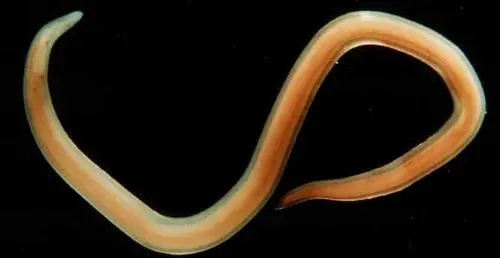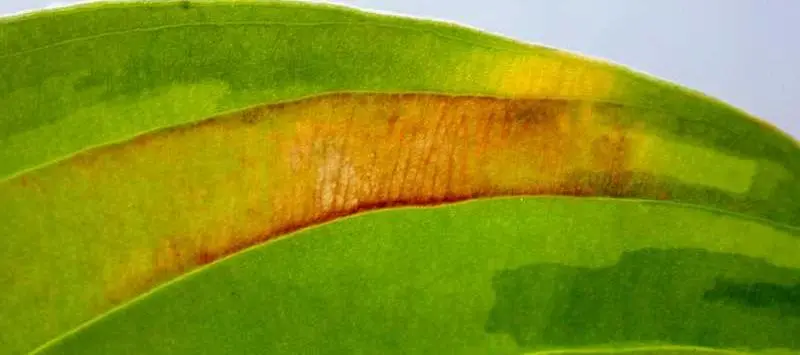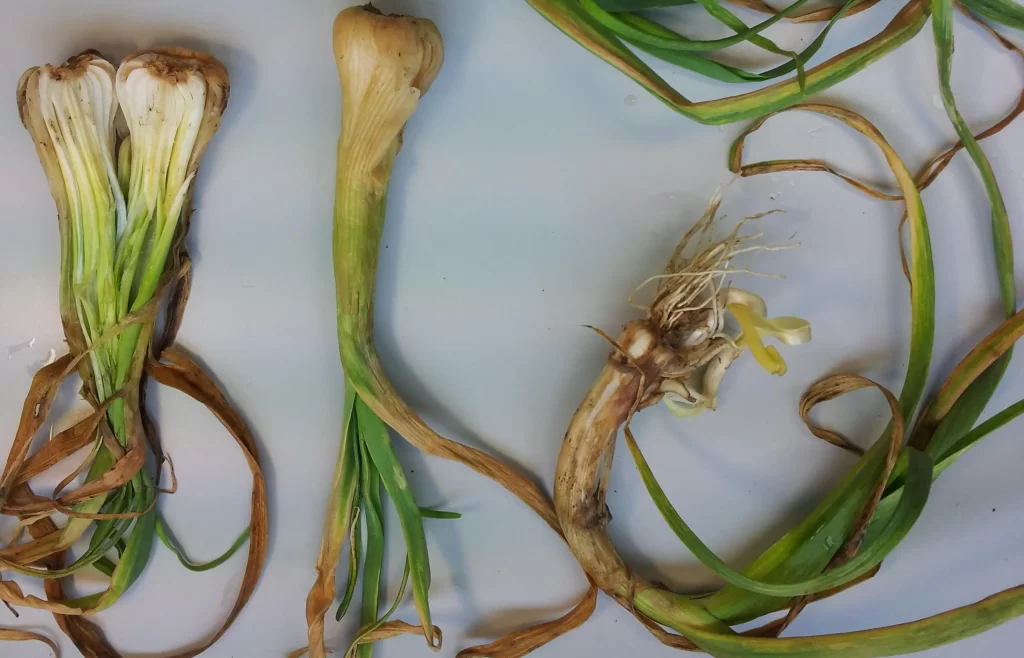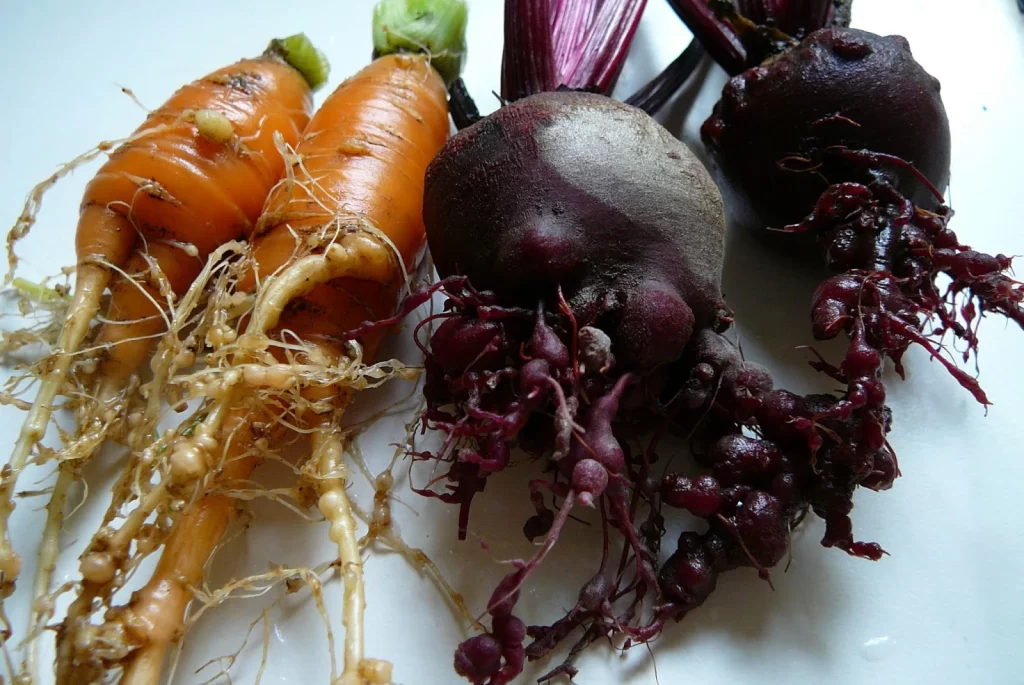Nematodes are small, no more than 2 mm, round worms that settle and live in moist soil, on plants or inside them. Due to their very small size, nematodes remain unnoticed for a long time and become visible only when the plant has been severely damaged.
Nematodes damage various plant tissues: seeds, flowers, buds, leaves, stems, roots, piercing their tissues with a skeleton and introducing digestive enzymes that disrupt the normal functioning of the affected organs. As a result, there is inhibition of plant growth and development, the stem is distorted and deformed, the buds dry up. Externally infected plants look underdeveloped: their leaves may be coarser, the internodes are shortened, the leaves dry up, galls may form on the roots.

What are Nematodes?
Leaf nematode
Leaf nematode (genus Aphelenchoides) – microscopic worms, colorless, up to 1 mm long, move quickly.
Leaf nematodes include: chrysanthemum nematode (Aphelenchoides ritzemabosi) and strawberry nematode (A.fragariae) – parasitic in the aboveground part of the plant, on the leaves, flowers and stems of chrysanthemums and strawberries. Nematodes penetrate into plant tissue through cracks and wounds.

External signs
In the place where the pest damages the leaf tissues, the leaves discolor, become covered with yellowish spots, which are slightly translucent in the light, and then become dark brown and purple and, over time, dry up. The nematode develops and reproduces on the same plant and lives until its complete death. In one leaf can be up to 15 thousand individuals of nematodes at different stages of development. The soil is a temporary habitat for these nematodes, in dry leaves at a temperature of about 5 ° C they can successfully overwinter.
Nematode prevention
When spraying plants, let them dry faster. The soil must be sterilized (within 30 minutes) before use.
Control measures
It is almost impossible to use chemicals at home. Affected plants should be destroyed along with the earth lump; pot, plate thoroughly washed with hot water; the place where the infected plant stood, wash thoroughly.
Stem nematode
Stem nematode (genus Ditylenchus) is a small filamentous worm up to 1.7 mm long – a pest of flower crops.
Penetrating from the soil through the roots, the larvae of the stem nematode climb into the tissues of leaves and flower stalks. Unlike the leaf nematode, the stem nematode causes thickening of the tissues in the affected areas. Stem nematodes adapt to certain plant species and do not infect other species. The most common diseases are begonias, tulips, hyacinths, phlox, cloves, onions, garlic and others. Plants are characterized by distorted development of stems of leaves and flowers. Shoots are shortened and have rough places. Affected parts have an unnaturally pale color, and eventually turn brown and die.

Control measures
Horticultural bulbs can be tried to treat the effects of high temperatures, to which not all species of nematodes are resistant. To do this, the bulbs are heated for 15 minutes in hot, about 45-48 degrees, water, then the bulbs should be rinsed and be sure to dry.
Root nematodes
Root nematodes (Meloidogyne marioni) – filamentous worms that form rough damage to plant roots; length of nematodes up to 2 mm, females – swollen, up to 1 mm long.
More than 2,000 species of plants are damaged: mostly vegetables and cereals, ornamental, herbaceous plants, trees and shrubs.
Inside the root is a female that lays up to 2,000 eggs during its lifetime. Pests hatch at the roots and feed heavily on the sap of the plant, turning into a stationary female or a mobile male, which leaves its environment in search of females. Development takes 19-45 days. The growth and development of nematodes contribute to moderate soil moisture and temperatures of 20-30 ° C.
External signs of infection
Affected plants lag behind in growth, tend to curl in warm weather and form very few thin roots. Small affected areas appear on the roots: rounded or elongated in shape. Initially, these lesions have a dull yellow color, then, as the disease progresses, they become darker brown.
Depending on the degree of damage, infected plants grow poorly, show signs of water deficiency and nutrient deficiencies.
In some plants, small swellings or nodules form on the roots. They serve to accumulate nutrients.
Preventive measures
With individual planting, the infection is relatively easy to localize. First of all, you should work very carefully and quickly: loosening the soil in pots should be carried out with tools disinfected in 2-5% solution of formalin or lysol. Untested plants should not be planted together. Each new plant should be planted in a separate container and quarantined.
The duration of quarantine is due to the generation (up to 60 days) cycle of the nematode.
One of the most effective methods of controlling nematodes is heat treatment of the soil: before planting, sterilize the soil (for 1 hour) at a temperature of 200 degrees.
Ultraviolet rays have a negative effect on the nematode.
This photo clearly shows the difference between a healthy plant and an infected nematode. In this case, the infected potatoes are underdeveloped.
Ways of nematodes:
- natural soil;
- nematodes are also found in sod, leaf, coniferous soil, even sphagnum;
- organic fertilizers (manure), especially bird droppings.
Control measures
Control of systemic and contact chemicals.
Destruction of nematodes is carried out by spraying plants 2-4 times with an interval of 3-5 days with 0.02% solution of mercaptophos or phosphamide (BI-58, ragora). However, they do not kill eggs in their hard chitinous shells. When the poison eventually expires, the parasites will hatch.

One way to control the nematode is to heat the roots.
The affected plant is removed from the ground, the roots are washed from the ground. Then the roots and the whole plant are washed in water at a temperature of 50-55 ° C. This temperature effect is one of the most reliable ways to control root pests, so the optimum temperature that promotes the reproduction of nematodes is 18-24 ° C, and at temperatures above 40 ° C the nematode dies. The most resistant to changes in living conditions are nematode eggs.
There are no reliable data on the duration of thermal exposure: the temperature ranges from 5 to 15-20 minutes. This temperature is safe for plants and reliably kills pests.

